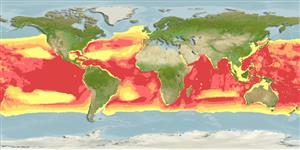Common names from other countries
Environment: milieu / climate zone / depth range / distribution range
Ecologie
Pelagisch; oceanodroom (Ref. 75906); diepteverspreiding 0 - 3793 m (Ref. 94963), usually 500 - 1100 m (Ref. 80612). Tropical; 90°N - 90°S, 180°W - 180°E
Atlantic Ocean and Indo-Pacific.
Length at first maturity / Size / Gewicht / Leeftijd
Maturity: Lm ?, range 210 - 220 cm Max length : 270 cm TL mannelijk/geslacht niet bekend; (Ref. 1394); Maximaal gepubliceerd gewicht: 210.0 kg (Ref. 1394)
Robust. Short beak, subtriangular to weakly falcate dorsal fin, pointed flippers, and relatively small concave flukes. Dark bluish to brownish-gray dorsal cape, pale gray flank, and white to pinkish belly. Wide dark gray to black stripe extending from the eye to the anus, conspicuously set off by thin pale cream-colored borders.
Pantropical distribution. Dolphins are directly caught for use as shark-bait in Sta. Ana and Aparri, Philippines (Ref. 77119). Minimum depth from Ref. 116169. Often seen near shore, along the outer continental shelf and in deep oceanic waters (Ref. 80620). Feeds in deep waterse (Ref. 122680). Feeds on mid-water fish, squid and crustaceans (Ref. 1394). Forms large social groups (Ref. 122680). Occasionally sighted with melon-headed whales, Peponocephala electra. (Ref. 80612).
Does not show strong evidence of seasonality in calving (Ref. 80616).
Tan, J.M.L. 1995. (Ref. 936)
Status op de Rode Lijst van het IUCN (Ref. 130435)
Status bij CITES (Ref. 108899)
Gebruik door de mens
Visserij: commercieel; aas: usually
FAO - Visserij: soortsprofiel | FishSource | Sea Around Us
Tools
Internet-bronnen
Estimates based on models
Preferred temperature
(Ref.
115969): 1.5 - 3.8, mean 1.8 (based on 2563 cells).
Weerstandsvermogen
Hoog, minimale populatieverdubbelingstijd minder dan 15 maanden (K=0.48; tm=8).
Kwetsbaarheid
Moderate vulnerability (42 of 100).
Prijsklasse
Unknown.
